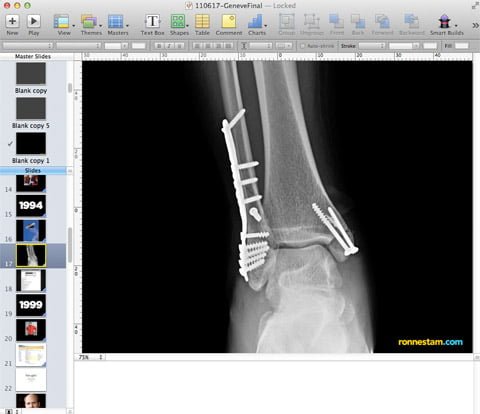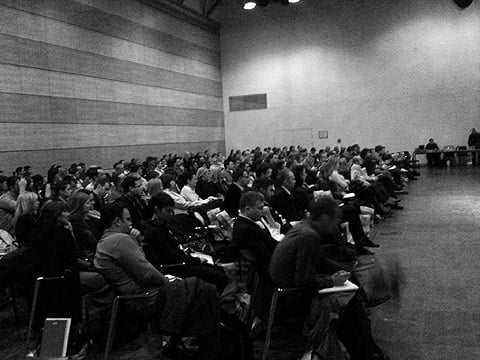Inspired by Swedish blogger Fredrik Wass who stated that he will blog for a 100 days in a row I felt I had to get my blog going again. So here we go!

Photographed by Paulina while forecasting trends at the Creative Summit together with among others Brian Solis and Alf Rehn.
In 2011 I was honored to be selected as the keynote speaker for events all over Europe. I delivered more than 80 keynotes on entrepreneurship, creative ideas, future branding, communication and business development, some of them shared here on Slideshare. In more than 90% of the occasions I was given the highest ranking of all the speakers by the audience. Hell, I even spoke for 24 hours in a row without any sleep. In other words – I’m confident I have some thoughts to share on how to deliver a great keynote presentation.
Here are 15 keys to deliver a fantastic keynote presentation.
1. Before even getting on stage – make sure you’ve got your logos, pathos and ethos wired.
What you speak about is 50% of your keynote, but the way you look and sound giving that keynote is the other 50%. The worlds first branding expert Aristotles knew how to make people buy what he sold. He divided the means of persuasion, appeals, into three categories; Ethos, Pathos and Logos.
– Ethos: the source’s credibility, the speaker’s/author’s authority
My credibility when I’m speaking is of course a mix of how I look, my credentials and the way I bring my message forward on stage. A common mistake I see over and over again is when speakers enter the stage and then go; “Before I speak, let me tell you about who I am and the company I’m representing.” This is more or less totally unnecessary since you’re there for a reason. If you do your thing right people will understand that you know your shit. After all, someone invited you so the people in front of you in the crowd will surely expect you to deliver. Remember that no one knows what you will say before you say it so don’t be to hard on yourself if you forget something you were supposed to say!

Who would you listen to if you were a banker? Who would you listen to if you were an Art Director?
An important thing though is to avoid making people angry (if that’s now what your assignment is) by dressing totally wrong, swearing or making fun of things that matter to the people in the room. A certain amount of selling should always be taken into account even if it requires you to dress up differently than you’re used to.
– Logos: the logic used to support a claim (induction and deduction); can also be the facts and statistics used to help support the argument.
When it comes to logos there’s different ways to handle this. Reliable statistics, famous quotes, facts and but also your own observations. However if you only bring up a observation as a proof of your theory you’ll tend to make people feel unsure about your whole presentaiton. But if you make sure to find patterns in historical information and present them in an understandable way you’re usually home free.

In 2007 I spoke about how Facebook would be the worlds most trafficked site with the help of this technical analysis of site traffic.
After all – if you are giving a keynote about future trends or an idea the world have never seen you will have to present logics that support your claims. The history if often your best friend when speaking about things in the future.
– Pathos: the emotional or motivational appeals; vivid language, emotional language and numerous sensory details.
Mirror mirror on the wall! Yes it’s actually true. The more you rehearse the better you get. Use your face, eyes, arms, voice and your whole body. Once you’ve got it wired get out there and rock the party!
2. If you don’t know the subject – don’t speak at all.
The worst presentations I’ve ever given over the years are the ones where I didn’t really master the subject. Avoid moments like that. Of course that shouldn’t keep you from challenging yourselves every now and then. But don’t choose the big arenas for those crying games.
3. Ask what your contractor want
I’ve learned that no one knows your audience better than your contractor. Therefor it’s key that you ask what they want to achieve with your keynote. Make people happy? Make people angry? Make people scared or give people hope. Still I don’t want to much information. It’s important that the contractor doesn’t shape my presentation After all, I am the professional. My solution is the five bullet point rule. Before every presentation I’m expected to give I ask my contractor to send me five short bullets that explains who I’m speaking in front, what they want them to learn, how they want the audience to feel once I’m done and what the goal with the event is.
4. Sell one thing!
This is an easy one so I’ll keep it short – If you’re selling fish don’t make up stories about dead meat. Make sure people understans that know one knows big fish as you do!
5. Drop the corporate bullshit
If you’re representing your company and is expeted to sell something then make sure you share your knowledge and people will ask you in the end what you sell. Nothing sells as competence. Trust people to contact you if they thought you knew what you were talking about. If you’re on stage purely focused on selling no one will listen to what you’re actually selling.
6. Drop the bullets.

Sometimes the best solution is to make fun of the worst.
No one wants you to read bullets from corporate slides. We’ve all been there. Stuck in the middle of an audience listening to some boring odd character looking not on us but instead on his own presentation and reading those bullets like dead people read poems…not good. Please stop giving keynotes if you don’t know how to sell your shit! Tons of corporate CEO’s are really good at this. They’re sent off to a stage somewhere in never-never-land expected to deliver a keynote with a deck of slides in their hands prepared by a assistent somewhere. I hate CEO’s speaking of shit they don’t know shit about. What’s up with that?
7. Drop the corporate fonts

Every slide in your deck should be there for a reason!
There’s nothing as boring as a presentation with one headline font and then another one for the rest. You’re on stage to inspire people, teach them something and especially keep them awake. No two slides should be the same.
8. Tell stories from your own life.

Preparing a keynote and a story about how my snowboard career ended.
Nothing brings life to a presentation like your own life. True stories that are coming from your own life are the best. People have never heard them before, they’re authentic and people out of some reason always count them as real stories. Of course, if you end up telling stories about Marsians and shit like that people will probably not belive you.
9. You’ve also got ‘black’ slides in your deck!

This is your most valuable slide!
In the world of photoshop, keynote, powerpoint and prezis maybe the most valuable color of them all – black – is often forgotten. If you’ve got something to say that you really really really want people to listen to. Place a black slide in the middle of the deck and let those words out without distraction. If you’re doing it right you’ll have your audience spellbound.
10. Rehearse, rehearse and rehearse some more.
This is one of the things I’m really bad at. But every time I’ve done a presentation that I’m really proud of I’ve almost rehearsed it. I even rehearse presentations that I know by heart already. You can never rehearse enough!
11. It’s your stage. Then make sure it fits your needs.
One of the key factors to delivering a great keynote is the actuall stage. Far to many times have I entered a stage that didn’t match the venue. Maybe the stage was to big compared to how many people visited the event or vice versa. Every now and then someone has placed a wide table between you and the audience – remove it. If people take their places far back in the room – leave the stage and get closer to them. The last thing you want is an audience that thinks your on stage acting superior and distant.
12. One minute before entering the stage

An audience in Zagreb minutes before I’m entering the stage.
Ok, so you’re all done and prepared to give the speech of your life. Remember those five bullet points I wrote about. Now it’s time to get into presentation mode. When I’m waiting to enter the stage I think about these five bullets. The most important one however is how did my contractor want people to feel once I’m done. If they wanted me to make people happy I’m smiling like a dumbass those last 60 seconds. I they wanted me to provoke the audience I’m getting myself psyched up and angry. If they wanted me to make people feel enlightened I’m getting ready to enlighten people. And then I do my best to keep that feeling alive all through the presentation.
13. If something goes wrong – restart yourselves.
Once you’re up there doing your best you will experience moments of dispair. You might see someone in the audience looking bored, someone looks tired or maybe you’ll get an angry comment. Now is the time to seek your inner strenght. Think back to that presentation mode you were supposed to deliver upon. Take a breath, pause, make people wait and then restart. You’ll notice that this will get you back on track!
14. Never lose track of time.

Make sure you prepare your presenter display right.
Rule number one of all presentations. If you’ve got 20 minutes it’s 20 minutes. Not less and definitely not more. If you’re using Apple Keynote you should make sure to set up your second screen with timer and a clock. Another good idea can be to download an app that Per Axbom told me about. It’s called Timer for iPhone and let’s you set up sections to keep track of time. It’s a great help!
15. Shine!
Now it’s up to you! Rock on!